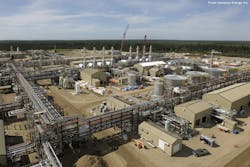Cenovus lifts 2017 capital budget by 24%, to resume Christina Lake expansion
Cenovus Energy Inc., Calgary, in 2017 plans to invest $1.2-1.4 billion, a 24% increase compared with the firm’s forecast capital spending for 2016.
The budget includes capital for construction of the Phase G expansion at its Christina Lake oil sands project, resumption of which is planned for the first half.
Cenovus says it has reworked the construction plan and rebid contracts for the project to reduce costs since deferring Phase G in late 2014 because of declining crude oil prices. After realizing more than $500 million in project cost savings, the firm anticipates the expansion can be completed with go–forward capital investment of $16,000-18,000/flowing barrel.
Phase G is about 20% complete and has an approved design gross capacity of 50,000 b/d. Production startup from the expansion is expected in second-half 2019.
The firm also continues to advance its portfolio of regulatory-approved oil sands projects, intending to spend capital to progress engineering work on deferred projects at Foster Creek and Narrows Lake.
Cenovus’s total oil sands capital budget for the year ahead includes $300-350 million for Christina Lake, $325-375 million for Foster Creek, and $60-90 million for emerging oil sands projects.
Oil sands to boost company output
In 2016, Cenovus completed work on two new expansion projects, increasing its oil sands production capacity by 26% to 390,000 b/d gross, of which 195,000 b/d is net to Cenovus. Christina Lake Phase F, which includes a 100-Mw cogeneration plant, began production last month, with ramp-up expected over 12 months. Production from Foster Creek Phase G started up early in the third quarter, and also is expected to ramp up over 12 months.
In recent weeks, Christina Lake has been producing about 92,000-98,000 b/d net, while Foster Creek has been producing 80,000-85,000 b/d net. Over the long term, Cenovus continues to target oil sands production at 90-95% of design capacity.
In 2017, as the expansions at Christina Lake and Foster Creek continue, Cenovus plans to increase its oil sands production by 20% compared with its forecast 2016 production. Total oil production, including oil sands and conventional combined, is forecast to increase 14% compared with the company’s 2016 forecast.
Conventional oil production is forecast to decrease 4%, largely due to expected natural declines. The firm anticipates incremental production from the Palliser drilling program will offset some of those declines, with the greatest impact expected in 2018.
Cenovus plans a targeted drilling program on Palliser block in southern Alberta where it has “a large inventory of highly attractive short-cycle tight oil opportunities.” The firm says it has identified 700 drilling locations to date with high-return potential. It plans to spend $160 million in the year ahead to drill about 50 horizontal development wells and 60 stratigraphic wells at Palliser.
Cenovus now expects its long-term oil sands sustaining capital to be close to $7/bbl, about 50% lower than in 2014. The firm intends to cover all of its 2017 sustaining capital costs as well as its dividend with a West Texas Intermediate oil price of $45-50/bbl.
With integration remaining an important part of the company’s overall strategy, the firm plans to invest $210-240 million in its refining and marketing business in 2017. The capital is primarily for scheduled maintenance and reliability work at the Wood River and Borger refineries in the US that Cenovus jointly owns with operator Phillips 66.

